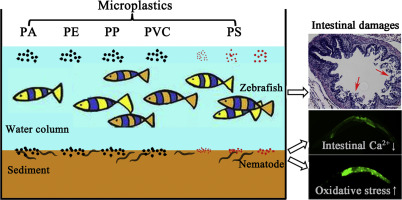Science of the Total Environment ( IF 8.2 ) Pub Date : 2017-11-11 , DOI: 10.1016/j.scitotenv.2017.11.103 Lili Lei , Siyu Wu , Shibo Lu , Mengting Liu , Yang Song , Zhenhuan Fu , Huahong Shi , Kathleen M. Raley-Susman , Defu He

|
Microplastics have been frequently detected in aquatic environments, and there are increasing concerns about potential effects on biota. In this study, zebrafish Danio rerio and nematode Caenorhabditis elegans were used as model organisms for microplastic exposure in freshwater pelagic (i.e. water column) and benthic (i.e. sediment) environments. We investigated the toxic effects of five common types of microplastics: polyamides (PA), polyethylene (PE), polypropylene (PP), polyvinyl chloride (PVC) and polystyrene (PS) particles. Results showed no or low lethality in D. rerio after exposure for 10 d at 0.001–10.0 mg L− 1 microplastics. The PA, PE, PP and/or PVC microplastics with ~ 70 μm size caused intestinal damage including cracking of villi and splitting of enterocytes. Exposure to 5.0 mg m− 2 microplastics for 2 d significantly inhibited survival rates, body length and reproduction of C. elegans. Moreover, exposure to microplastics reduced calcium levels but increased expression of the glutathione S-transferase 4 enzyme in the intestine, which indicates intestinal damage and oxidative stress are major effects of microplastic exposure. Among 0.1, 1.0 and 5.0 μm sizes of fluorescently labeled PS, 1.0 μm particles caused the highest lethality, the maximum accumulation, the lowest Ca2 + level in the intestine and the highest expression of glutathione S-transferase 4 in nematodes. Taken together, these findings suggest that intestinal damage is a key effect of microplastics; and that the toxicity of microplastics is closely dependent on their size, rather than their composition.
中文翻译:

微型塑料颗粒引起肠道损伤和在斑马鱼等不良影响斑马鱼和线虫秀丽隐杆线虫
在水生环境中经常检测到微塑料,因此人们越来越担心对生物群的潜在影响。在这项研究中,斑马鱼斑马鱼和线虫秀丽隐杆线虫被用作在淡水中上层微型塑料曝光(模式生物我。Ë。水柱)和底栖(我。ê。沉积物)的环境中。我们研究了五种常见的微塑料的毒性作用:聚酰胺(PA),聚乙烯(PE),聚丙烯(PP),聚氯乙烯(PVC)和聚苯乙烯(PS)颗粒。结果显示D无致死率或致死率低。鱼暴露10 d后,在0.001〜10.0毫克的L− 1种微塑料。尺寸约为70μm的PA,PE,PP和/或PVC微塑料会引起肠损伤,包括绒毛破裂和肠上皮细胞分裂。曝光至5.0mg米- 2个塑料微粒为2 d显著抑制存活率,体长和再现Ç。线虫。此外,暴露于微塑料中可降低钙水平,但增加肠道中谷胱甘肽S-转移酶4酶的表达,这表明肠道损伤和氧化应激是微塑料暴露的主要作用。在0.1、1.0和5.0μm大小的荧光标记PS中,1.0μm颗粒导致最高的杀伤力,最大的积累,最低的Ca 2 +在肠道中的水平和线虫中谷胱甘肽S-转移酶4的最高表达。综上所述,这些发现表明肠道损伤是微塑料的关键作用。而且微塑料的毒性密切取决于其尺寸,而不是其组成。











































 京公网安备 11010802027423号
京公网安备 11010802027423号